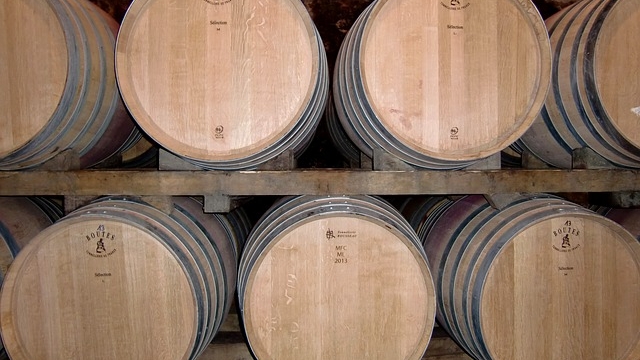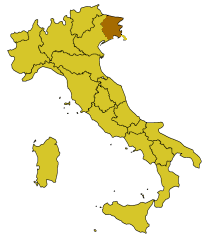That Useful Wine Site
Search, or just roll your cursor over the colored boxes farther below.click the “x” to dismiss Search-results block.




Advertisement:
Advertisement:
Quick page jumps:
(Synonyms: Pocalza, Poçalza, Pokalca, Pokalza, Ribolla Nera, Schioccoletto, Schiopetino, Schioppettino, and Scoppiettino.)

Schioppettino is a quite old red-wine grape originating in the Friuli-Venezia Giulia region of northeast Italy (see map at left), close to what is now Slovenia. That area remains the variety’s home today.
Schioppettino is another of the “re-discovered” grapes of Italy: grapes once close to extinction that are being rescued by proponents of their quality. As usual in these cases, after the the phylloxera epidemic of the late 19th century, re-plantings largely ignored older regional grapes—such as Schioppettino—in favor of the hugely popular “international” varieties. (By the 1960s there were fewer than 100 Schioppettino vines left in the world.) Fortunately, considerable attention is now being paid to the virtues of those old, once-well-established varieties.
Schioppettino wines typically have a stronly aromatic nose, medium body, and taste of dark fruits such as raspberry, flowers such as violets, and—quite notably—have a “peppery” overtone. Normally they have modest alcohol levels and pronounced acidity, which the strong fruit qualities nicely balance.
Factoid: Records show Schiopettino wine being used in marriage ceremonies at least as far back as 1282.
While there are several good Schioppettino bottlings in the U.S. market, all but one are very scarce—one or at most two on-line retailers. We list the one more widely available.
• This wine’s Wine Searcher “Reviews” page.
• This wine’s CellarTracker review pages.
• Retail offers of this wine listed by Wine Searcher.
• Retail offers of this wine listed by 1000 Corks.
Our nomination is the Ronchi Di Cialla Schiopettino, which retails for from about $46 to $80. Though its numerical ratings are only a little higher than the wine listed above, the reviews all seem exuberantly positive. (Paolo Rapuzzi of Ronchi Di Cialla is credited with having single-handedly saved and revived this fine grape.)
Beware offerings of half-bottles.
• This wine’s Wine Searcher “Reviews” page.
CellarTracker has four separate listings for this wine:
• This wine’s CellarTracker review pages.
• This wine’s CellarTracker review pages.
• This wine’s CellarTracker review pages.
• This wine’s CellarTracker review pages.
• Retail offers of this wine listed by Wine Searcher.
• Retail offers of this wine listed by 1000 Corks.
Advertisement:
Advertisement:
|
|
This site is one of The Owlcroft Company family of web sites. Please click on the link (or the owl) to see a menu of our other diverse user-friendly, helpful sites. |
|
| (Note: All Owlcroft systems run on Ubuntu Linux and we heartily recommend it to everyone—click on the link for more information). | ||
|
All content copyright © 2024 The Owlcroft Company
(excepting quoted material, which is believed to be Fair Use). |
This web page is strictly compliant with the W3C (World Wide Web Consortium) Extensible HyperText Markup Language (XHTML) Protocol v1.0 (Transitional) and the W3C Cascading Style Sheets (CSS) Protocol v3 — because we care about interoperability. Click on the logos below to test us!
This page was last modified on Saturday, 6 November 2021, at 11:32 pm Pacific Time.
Some Descriptions of Schioppettino Wines
“[I]t produces very aromatic, medium bodied wines with Rhône-like qualities of deep dark coloring with violet, raspberry and pepper notes.”
“Most Schioppettino wines are medium-bodied, deeply-colored, aromatic on the nose (violets and red berries) and spicy to the palate ("peppery" and "earthy" are oft-encountered descriptors). Schioppettino is most often produced as a dry red wine, but can also be made into sparkling spumante versions - a local specialty of Friuli.”
“Speciality of Friuli whose characterful wines hint at violets and pepper.”
“Think of Schioppettino as a cross between Syrah and Cabernet Franc…Schioppettino is naturally high in rotundone, the compound found in black pepper. It has a distinct peppercorn character, along with floral and green notes. While Schioppettino is most beloved for these expressive non-fruit aromas and flavors, high acidity lifts red and blue fruit as well, creating balanced, complex, medium-bodied wines.”
“Schioppettino is a dry Italian red wine packed with intense red fruit notes, like fresh cherries and strawberries, together with distinctive aromas of black pepper and violets. The refreshing acidity and high but fine tannins are balanced perfectly with medium body and alcohol…The red color of Schioppettino can vary in deepness from medium to deep. However, it is always bright ruby, sometimes with purple highlights. In that way, it can look like Cabernet or Syrah. Schioppettino is aromatic and offers very complex aromas. The first impression is fruity with fresh cherry, strawberry. The second layer of aromas brings notes of black pepper and violets. Sometimes fine vanilla or clove can also be present. This is a medium-bodied red wine with bright acidity and fine tannins. The alcohol can vary from 12.5 to 14% and always brings good harmony. It is a dry wine that is very refreshing on the palate with bright fruit notes of raspberry and cherry. It usually ends with a long velvety finish.”
“When fully developed, the Schioppettino variety gives off some richly aromatic experience with deep flavours of cherries and blackberries, mixed with some hints of chocolates and smoke, these characteristics being attributed to its vinification process in oak barrels.”
“This is a grape with rich potential, typically vinified in stainless-steel and matured in used barriques. Schioppettino is deeply coloured, medium bodied, with charming violet aromatics and a certain Northern Rhone (Syrah) peppery quality, Alpine-fresh acidity, and few tannins to speak of.”
“The wine, grown exclusively on the hills around the municipalities of Albana and Prepotto in the southeastern part of the zone, is considered a cult wine admired for its distinct, robust and almost rustic appearance…[It} has a scent of fresh berries and herbs, as well as a pronounced acidity, which decreases after 4-6 years, when the wine develops more depth and mellowness. The color is ruby red, but it turns garnet with age.”
“There is a similar kind of game played by great Barolos, Brunellos, Chianti Classicos and Etna Rossos. These are rarely, nor should they be huge blockbuster wines. The magic is all in that delicate balance. The same ought to be said of Schioppettino, a variety that has survived near extinction to become one of Friuli’s finest and most characterful reds…[T]he best Schioppettinos have tension, grip and a certain herbaceousness that is quite specific to the variety. Green peppercorn is a calling card, sometimes with balsamic or citrus peel hints. Maturity is important, and although current releases…can show very well, it’s not the whole story. Even a couple more years’ aging can be vital for better integration and complexity – and a softening of the tannins, which can be quite abrupt in youth. The ability to age and improve with it is one sign of a truly fine wine – so whilst you can…drink the younger wines with a barbecue, the more prestigious and venerable vintages demand a little more ceremony.”
“The bouquet is marked by a dark fruit reminiscent of raspberries, blackberries, pepper and undergrowth: these are the typical aromas that will make you recognize the Ribolla Nera. Certainly with the years of refinement the tertiary sector develops and juniper, leaves, balsamic and spicy features emerge. It is not an aromatic grape and therefore you will not find exuberant aromas, but rather a delicate finesse played with masterful sensitivity. On the palate, it is sharp, sharp, built around an acidity that makes it compelling and always lively. The tannins are fine-grained but powerful, while the structure is good, never exaggerated.”
“The grape…creates intensely colored red wines with a medium body and a spicy, peppery-like note on the palate. The aroma is reminiscent of red and black berries, often with hints of violet and herbal and balsamic notes. The wines are smooth and well-balanced with tannins and acidity. They can range from fresh and approachable styles that are best enjoyed young to more complex, age-worthy examples.”